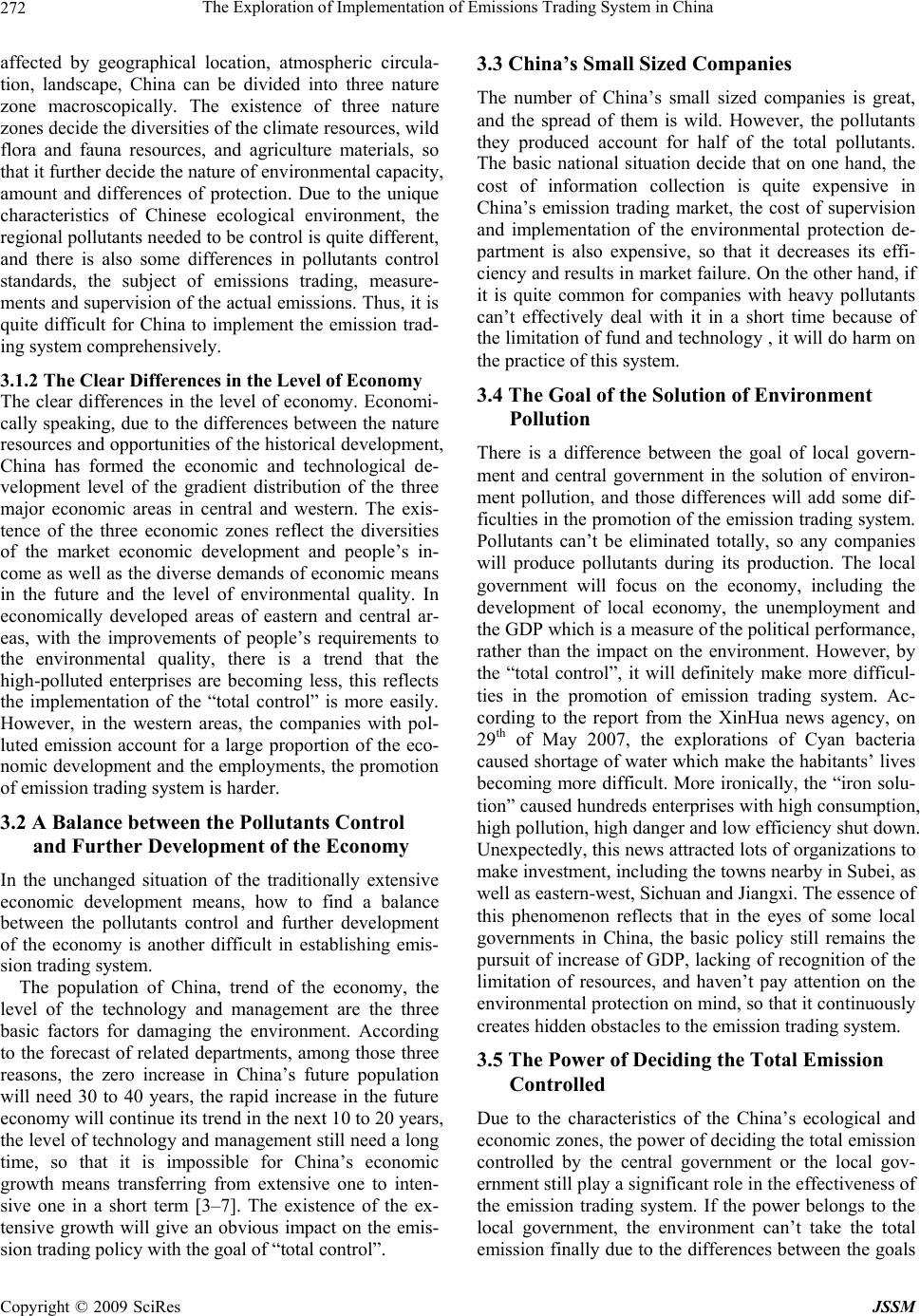
The Exploration of Implementation of Emissions Trading System in China
272
affected by geographical location, atmospheric circula-
tion, landscape, China can be divided into three nature
zone macroscopically. The existence of three nature
zones decide the diversities of the climate resources, wild
flora and fauna resources, and agriculture materials, so
that it further decide the nature of environmental capacity,
amount and differences of protection. Due to the unique
characteristics of Chinese ecological environment, the
regional pollutants needed to be control is quite different,
and there is also some differences in pollutants control
standards, the subject of emissions trading, measure-
ments and supervision of the actual emissions. Thus, it is
quite difficult for China to implement the emission trad-
ing syst em compr eh en sively.
3.1.2 The Clear Differences in the Level of Economy
The clear differences in the level of economy. Economi-
cally speaking, due to the differences between the nature
resources and opportunities of the historical development,
China has formed the economic and technological de-
velopment level of the gradient distribution of the three
major economic areas in central and western. The exis-
tence of the three economic zones reflect the diversities
of the market economic development and people’s in-
come as well as the diverse demands of economic means
in the future and the level of environmental quality. In
economically developed areas of eastern and central ar-
eas, with the improvements of people’s requirements to
the environmental quality, there is a trend that the
high-polluted enterprises are becoming less, this reflects
the implementation of the “total control” is more easily.
However, in the western areas, the companies with pol-
luted emission account for a large proportion of the eco-
nomic development and the employments, the promotion
of emission trading system is harder.
3.2 A Balance between the Pollutants Control
and Further Development of the Economy
In the unchanged situation of the traditionally extensive
economic development means, how to find a balance
between the pollutants control and further development
of the economy is another difficult in establishing emis-
sion trading system.
The population of China, trend of the economy, the
level of the technology and management are the three
basic factors for damaging the environment. According
to the forecast of related departments, among those three
reasons, the zero increase in China’s future population
will need 30 to 40 years, the rapid increase in the future
economy will continue its tren d in the nex t 10 to 20 years,
the level of tech nology and manag ement still need a long
time, so that it is impossible for China’s economic
growth means transferring from extensive one to inten-
sive one in a short term [3–7]. The existence of the ex-
tensive growth will give an obvious impact on the emis-
sion trading policy with the goal of “total control”.
3.3 China’s Small Sized Companies
The number of China’s small sized companies is great,
and the spread of them is wild. However, the pollutants
they produced account for half of the total pollutants.
The basic national situation decide that on one hand, the
cost of information collection is quite expensive in
China’s emission trading market, the cost of supervision
and implementation of the environmental protection de-
partment is also expensive, so that it decreases its effi-
ciency and results in market failure. On the other hand, if
it is quite common for companies with heavy pollutants
can’t effectively deal with it in a short time because of
the limitation of fund and technology , it will do harm on
the practice of this system.
3.4 The Goal of the Solution of Environment
Pollution
There is a difference between the goal of local govern-
ment and central government in the solution of environ-
ment pollution, and those differences will add some dif-
ficulties in the promotion of the emission trading system.
Pollutants can’t be eliminated totally, so any companies
will produce pollutants during its production. The local
government will focus on the economy, including the
development of local economy, the unemployment and
the GDP which is a measure of the political performance,
rather than the impact on the environment. However, by
the “total control”, it will definitely make more difficul-
ties in the promotion of emission trading system. Ac-
cording to the report from the XinHua news agency, on
29th of May 2007, the explorations of Cyan bacteria
caused shortage of water which make the habitants’ lives
becoming more difficult. More ironically, the “iro n solu-
tion” caused hundreds enterprises with high consumption,
high pollution, high danger and low efficiency shut down.
Unexpectedly, this news attracted lots of organ izations to
make investment, including the towns nearby in Subei, as
well as eastern-west, Sichuan and Jiangxi. The essence of
this phenomenon reflects that in the eyes of some local
governments in China, the basic policy still remains the
pursuit of increase of GDP, lacking of recognition of the
limitation of resources, and haven’t pay attention on the
environmental protection on mind, so that it continuously
creates hidden obstacles to the emission trading system.
3.5 The Power of Deciding the Total Emission
Controlled
Due to the characteristics of the China’s ecological and
economic zones, the power of deciding the total emission
controlled by the central government or the local gov-
ernment still play a significant role in the effectiv eness of
the emission trading system. If the power belongs to the
local government, the environment can’t take the total
emission finally due to the differences between the goals
Copyright © 2009 SciRes JSSM